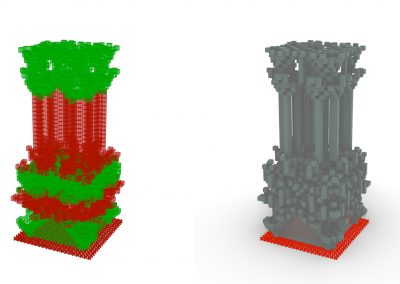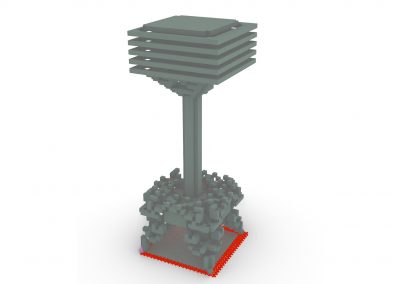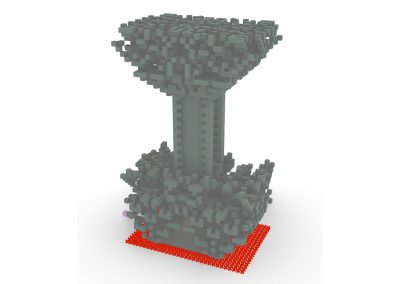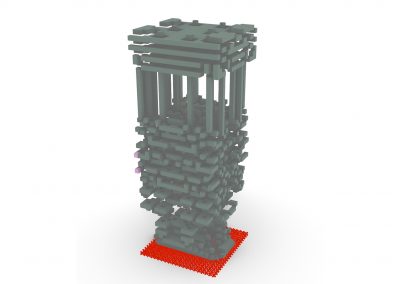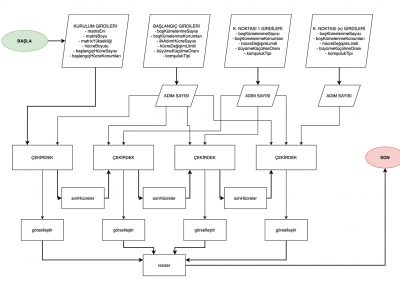Hücresel Özdevinim Tabanlı Kütle Modelleme Algoritması Geliştirilmesi
Çalışma, yüksek yapıların tasarımına yönelik, kullanıcı müdahalesini mümkün kılan bir kütle modelleme aracı geliştirmeyi konu olarak ele almaktadır. Belirme kavramı etrafında şekillenen çalışmada bir üretken sistem metodu olan hücresel özdevinim temel alınmış ve algoritma bu metot üzerine kurgulanmıştır. Algoritma, yüksek yapı tasarımlarında sıklıkla karşılaşılan homojen mekanların aksine farklı mekansal ihtiyaçlara yönelik farklı işlevlere sahip olan heterojen mekanlar üretmeyi hedeflemiş olup, bu heterojenliği doluluk – boşluk ilişkisi üzerinden sağlamaktadır. Kullanıcının çalışma alanının sınırlarına, birimlerin boyutlarına, büyüme ilişkisine ve tasarım sürecine müdahale edeceği noktaları seçmesine imkan tanıyan algoritma Rhinoceros 7 – Grasshopper ortamında geliştirilmiştir. Süreç esnasında hazır bileşenler ve eklentiler kullanılırken, ihtiyaca yönelik C# tabanlı betikler de yazılmıştır. Temel olarak iki aşamada gerçekleşen algoritma geliştirme sürecinin ilk aşamasında kullanıcı müdahalesine odaklanılmış ve buna uygun çalışma ortamı sağlayabilmek adına ‘Rabbit’ isimli Grasshopper eklentisinin bünyesinde barındırdığı Conway tarafından geliştirilen ‘Game of Life’ modeli kullanılmıştır. İkinci aşamada ise çalışma amacına yönelik bir hücresel özdevinim tabanlı bir algoritma geliştirilmiş ve kullanıcı müdahalesine imkan tanıyan fonksiyonlar bu algoritmaya entegre edilmiştir. Çalışma sonunda her iki aşamadan da elde edilen çıktılar incelenmiş ve örnekler üzerinden değerlendirmeler yapılmıştır.
Cellular Automata Based Mass Modeling Algorithm
Main topic of the study is to develop a mass modeling tool for the design process of high-rise structures. The study, which is shaped around the concept of emergence, is based on cellular automata which is a generative system method and the algorithm is developed on it. Unlike homogeneous spaces that are frequently encountered in high-rise building, the algorithm aims to generate heterogeneous spaces with different functions for different spatial needs and provides this heterogeneity through the occupancy – space relationship. The algorithm which allows its users to select the boundaries of the workspace, size of the units, the growth relationship and the points to interfere with design process, is developed in Rhinoceros 7 – Grasshopper environment. While default components and plug-ins are used during the process, C# based scripts are also written. Algorithm is developed in two different stages. In the first stage, focus is on user intervention and in order to provide a suitable working environment, a component of Rabbit plug-in which includes Game of Life of Conway is used. In the second stage, a cellular automata based algorithm is developed for the purpose of the study and the functions that allow user intervention are integrated into this algorithm. At the of the study, the outputs obtained from both stages are examined and evaluated through examples.
© 2021 Istanbul Technical University Graduate School, Department of Informatics, Architectural Design Computing Program. All Rights Reserved
